Spatial Mapping of Thermal Anomalies and Change Detection in the Sierra Madre Occidental, Mexico, from 2000 to 2024
Abstract
1. Introduction
2. Materials and Methods
2.1. Study Site
2.2. Land Surface Temperature (LST) Dataset
2.3. LST Validation
2.4. LST Anomalies
2.5. Change Detection of LST in the SMO
3. Results
3.1. LST
3.2. LST vs. In Situ Temperature
3.3. Anomalies by Vegetation Coverage
3.4. Change Detection
4. Discussion
5. Conclusions
Supplementary Materials
Author Contributions
Funding
Data Availability Statement
Conflicts of Interest
References
- Hansen, J.M.; Sato, M.; Ruedy, K.; Lo, K.; Lea, D.W.; Medina-Elizade, M. Global temperature change. Proc. Natl. Acad. Sci. USA 2006, 103, 288–293. [Google Scholar] [CrossRef]
- Schmugge, T.J.; Becker, F. Remote sensing observations for the monitoring of land-surface fluxes and water budgets. In Land Surface Evaporation: Measurements and Parameterization; Schmugge, T.J., Andre, J.C., Eds.; Springer: New York, NY, USA, 1991; Volume 20, pp. 337–347. [Google Scholar]
- Running, S.W.; Nemani, R.R.; Heinsch, F.A.; Zhao, M.; Reeves, M.; Hashimoto, H. A continuous satellite-derived measure of global terrestrial primary production. BioScience 2004, 54, 547–560. [Google Scholar] [CrossRef]
- Ackerman, S.A.; Strabala, K.I.; Menzel, W.P.; Frey, R.A.; Moeller, C.C.; Gumley, L.E. Discriminating clear sky from clouds with MODIS. J. Geophys. Res. Atmos. 1998, 103, 32141–32157. [Google Scholar] [CrossRef]
- Wright, R.; Carn, S.A.; Flynn, L.P. A satellite chronology of the May–June 2003 eruption of Anatahan volcano. J. Volcanol. Geotherm. Res. 2005, 146, 102–116. [Google Scholar] [CrossRef]
- White, J.C.; Coops, N.C.; Wulder, M.A.; Vastaranta, M.; Hilker, T.; Tompalski, P. Remote Sensing Technologies for Enhancing Forest Inventories: A Review. Can. J. Remote Sens. 2016, 42, 619–641. [Google Scholar] [CrossRef]
- Beniston, M. Climatic change in mountain regions: A review of possible impacts. Clim. Change 2003, 59, 5–31. [Google Scholar] [CrossRef]
- Adler, C.; Wester, P.; Bhatt, I.; Huggel, C.; Insarov, G.; Morecroft, M.; Muccione, V.; Prakash, A.; Alcantara-Ayala, I.; Allen, S.K.; et al. Mountains. In Climate Change 2022: Impacts, Adaptation and Vulnerability Working Group II Contribution to the Sixth Assessment Report of the Intergovernmental Panel on Climate Change; Cambridge University Press: Cambridge, UK, 2022; pp. 2273–2318. [Google Scholar]
- Iverson, L.R.; Prasad, A.M. Predicting abundance of 80 tree species following climate change in the Eastern United States. Ecol. Monogr. 1998, 68, 465–485. [Google Scholar] [CrossRef]
- Ohlemüller, R.; Gritti, E.S.; Sykes, M.T.; Thomas, C.D. Quantifying components of risk for european woody species under climate change. Glob. Change Biol. 2006, 12, 1788–1799. [Google Scholar] [CrossRef]
- Villers-Ruíz, L.; Trejo-Vázquez, I. Climate change on mexican forest and natural áreas. Glob. Environ. Change 1998, 8, 141–157. [Google Scholar] [CrossRef]
- Watson, R.T.; Zinyowera, M.C.; Moss, R.H. Climate Change 1995: Impacts, Adaptations and Mitigation of Climate Change, Scientific-Technical Analyses. In Contribution of Working Group II to the Second Assessment of the Intergovernmental Panel on Climate Change; Cambridge University Press: Cambridge, UK, 1996; p. 577. [Google Scholar]
- Moreno-Sanchez, R.; Buxton-Torres, T.; Sinbernagel, K.; Moreno-Sanchez, F. Fragmentation of the forests in Mexico: National level assessments for 1993, 2002 and 2008. Rev. Int. Estadística Geogr. 2014, 5, 4–18. [Google Scholar]
- Altamirano del Carmen, M.A.; Gay-García, E.C. A new method for assessing the performance of general circulation models based on their ability to simulate the response to observed forcing. J. Clim. 2021, 34, 5385–5402. [Google Scholar] [CrossRef]
- Rzedowski, J. Reflexiones y experiencias sobre el trabajo florístico en México. In Entre las Plantas y la Historia; Universidad Michoacana de San Nicolás de Hidalgo, Instituto de Investigaciones Históricas; Zamudio, G., Sánchez, D., Eds.; UNAM., Facultad de Ciencias, Universidad Nacional Autónoma de México y Sociedad Botánica de México: México, DF, Mexico, 1998; pp. 182–195. [Google Scholar]
- Mas, J.F. Assessing protected area effectiveness using surrounding (buffer) areas environmentally similar to the target area. Environ. Monit. Assess. 2005, 105, 69–80. [Google Scholar] [CrossRef]
- González-Elizondo, M. Indicadores de Cambio Climatico en Algunas Especies de Pinaceas de la Sierra Madre Occidental Mexico. Ph.D. Thesis, Universidad autonoma de Nuevo Leon, Nuevo Leon, Mexico, 2003; p. 193. [Google Scholar]
- González-Elizondo, M.S.; González-Elizondo, M.; Tena-Flores, J.A.; Ruacho-González, L.; López-Enríquez, I.L. Vegetación de la Sierra Madre Occidental, México: Una síntesis. Acta Botánica Mex. 2012, 100, 351–403. [Google Scholar] [CrossRef]
- Ferrari, L.; Valencia-Moreno, M.; Scott, B. Magmatismo y tectónica en la Sierra Madre Occidental y su relación con la evolución de la margen occidental de norteamérica. Bol. Soc. Geol. Mex. 2005, 57, 343–378. [Google Scholar] [CrossRef]
- Wan, Z.; Li, Z.L. Un algoritmo basado en la física para recuperar la emisividad y la temperatura de la superficie terrestre a partir de datos EOS/MODIS. IEEE Trans. Geosci. Remote Sens. 1997, 35, 980–996. [Google Scholar]
- Wan, Z.; Zhang, Y.; Zhang, Q.; Li, Z.-L. Quality assessment and validation of the MODIS global land surface temperature. Int. J. Remote Sens. 2004, 25, 261–274. [Google Scholar] [CrossRef]
- Servicio Meteorologico Nacional. Available online: https://smn.conagua.gob.mx/es/8-smn-general (accessed on 28 July 2025).
- Gonzalez-Alonso, F.; Cuevas, J.M.; Calle, A.; Casanova, J.L.; Romo, A. Spanish vegetation monitoring during the period 1987–2001 using NOAA-AVHRR images. Int. J. Remote Sens. 2004, 25, 3–6. [Google Scholar] [CrossRef]
- Jamali, A.A.; Kalkhajeh, R.G.; Randhir, T.O.; He, R.S. Modeling relationship between land surface temperature anomaly and environmental factors using GEE and Giovanni. J. Environ. Manag. 2022, 302, 113970. [Google Scholar] [CrossRef]
- Beck, R.N.; Gessler, P.E. Technical Note: Development of a Landsat Time Series for Application in Forest Status Assessment in the Inland Northwest United States. West. J. Appl. 2008, 23, 53–62. [Google Scholar] [CrossRef]
- Geoportal del Sistema Nacional de Informacion Sobr Biodiversidad (SNIB). Available online: http://geoportal.conabio.gob.mx/ (accessed on 5 November 2024).
- Aguilar-Soto, V.; Melgoza-Castillo, A.; Villarreal-Guerrero, F.; Wehenkel, C.; Pinedo-Alvarez, C. Modeling the Potential Distribution of Picea chihuahuana Martínez, an Endangered Species at the Sierra Madre Occidental, Mexico. Forests 2015, 6, 692–707. [Google Scholar] [CrossRef]
- Morton, J.C. Image Analysis, Classification and Change Detection in Remote Sensing, 4th ed.; CRC Press; Taylor and Francis: Boca Raton, FL, USA, 2019; pp. 375–397. [Google Scholar]
- SDMToolbox. Available online: http://www.sdmtoolbox.org/ (accessed on 30 July 2025).
- Mildrexler, D.J.; Zhao, M.; Cohen, W.B.; Running, S.W.; Song, X.; Jones, M.O. Thermal anomalies detect critical global land surface changes. J. Appl. Meteorol. Climatol. 2018, 57, 391–397. [Google Scholar] [CrossRef]
- Yang, C.; Yan, F.; Zhang, S. Comparison of land surface and air temperatures for quantifying summer and winter urban heat island in a snow climate city. J. Environ. Manag. 2020, 265, 110563. [Google Scholar] [CrossRef]
- He, J.; Zhao, W.; Li, A.; Wen, F.; Yu, D. The impact of the terrain effect on land surface temperature variation based on Landsat-8 observations in mountainous areas. Int. J. Remote Sens. 2019, 40, 1808–1827. [Google Scholar] [CrossRef]
- Heyerdahl, E.K.; Alvarado, E. Influence of climate and land use on historical surface fires in pine-oak forests, Sierra Madre Occidental, Mexico. In Fire and Climatic Change in Temperate Ecosystems of the Western Americas; Thomas, T., Veblen, W.L., Baker, G.M., Thomas, W.S., Eds.; Springer: New York, NY, USA, 2003; Volume 7, pp. 196–217. [Google Scholar]
- Roy, A.; Rajasekaran, E.; Harod, R.; Gnanappazham, L. Land surface temperature anomalies as indicators of urban land cover change—A study of two Indian cities. Earth Sci. Syst. Soc. 2024, 4, 10096. [Google Scholar] [CrossRef]
- Novo-Fernández, A.; Franks, S.; Wehenkel, C.; López-Serrano, P.M.; Molinier, M.; López-Sánchez, C.A. Landsat time series analysis for temperate forest cover change detection in the Sierra Madre Occidental, Durango, Mexico. Int. J. Appl. Earth Obs. Geoinf. 2018, 73, 230–244. [Google Scholar] [CrossRef]
- Rosete-Vergés, F.A.; Pérez-Damián, J.L.; Villalobos-Delgado, M.; Navarro-Salas, E.N.; Salinas-Chávez, E.; Remond-Noa, R. El avance de la deforestación en México 1976–2007. Madera Y Bosques 2014, 20, 21–35. [Google Scholar] [CrossRef]
- National Hurricane Center. Available online: www.nhc.noaa.gov (accessed on 5 November 2024).
- Giovanni NASA Earth Data. Available online: www.earthdata.nasa.gov/data/tools/giovanni (accessed on 5 November 2024).
- Lugo, A.E. Visible and invisible effects of hurricanes on forest ecosystems: An international review. Austral Ecol. 2008, 33, 368–398. [Google Scholar] [CrossRef]
- Novais, S.; Macedo-Reis, L.E.; Cristobal-Peréz, E.J.; Sánchez-Montoya, G.; Janda, M.; Neves, F.; Quesada, M. Positive effects of the catastrophic Hurricane Patricia on insect communities. Sci. Rep. 2018, 8, 15042. [Google Scholar] [CrossRef]
- Zhao, B.; Mao, K.; Cai, Y.; Shi, J.; Li, Z.; Qin, Z.; Meng, X.; Shen, X.; Guo, Z. A combined Terra and Aqua MODIS land surface temperature and meteorological station data product for China from 2003 to 2017. Earth Syst. Sci. Data. 2020, 12, 2555–2577. [Google Scholar] [CrossRef]
- Zhao, B.; Sun, Z.; Wang, M.; Du, J.; Song, K. Tracking global large lake surface temperature variation from space using MODIS land surface temperature product. Ecol. Inform. 2025, 89, 103184. [Google Scholar] [CrossRef]
- Rocca, M.T.; Franzini, M.; Casella, V.M. Calibration and Validation of MODIS-Derived Ground-Level Air Temperature Models by Means of Ground Measurements. Appl. Sci. 2025, 15, 184. [Google Scholar] [CrossRef]
- Cortez-Villa, J.; Quevedo-Nolasco, A.; Arteaga-Ramírez, R.; Carrillo-Flores, G. Tendencia de la sequía meteorológica en el estado de Durango, México, por el método de Rodionov. Tecnol. Cienc. Agua. 2020, 11, 85–131. [Google Scholar] [CrossRef]
- Yu, W.; Ma, M.; Li, Z.; Tan, J.; Wu, A. New Scheme for validating remote-sensing land surface temperature products with station observations. Remote Sens. 2017, 9, 1210. [Google Scholar] [CrossRef]
- Sandoval, S.; López-González, C.; Escobar-Flores, J.G.; Martínez-Rincón, R.O. Effect of spatial resolution, algorithm and variable set on the estimated distribution of a mammal of concern: The squirrel Sciurus aberti. Écoscience 2020, 27, 195–207. [Google Scholar] [CrossRef]
- Bird, D.N.; Banzhaf, E.; Knopp, J.; Wu, W.; Jones, L. Combining. Spatial and Temporal Data to Createa Fine-Resolution Daily Urban Air Temperature Product from Remote Sensing Land Surface Temperature (LST) Data. Atmosphere 2022, 13, 1152. [Google Scholar] [CrossRef]
- Kio, P.R.O.; Ofosu-Asiedu, A.; Dykstra, D.P.; Kowero, G. Foreword to the second volume of the special issue containing refereed papers presented at thematic workshops during the CIFOR/UNEP project on sustainable forest management in Anglophone West Africa. Ghana J. For. 1997, 4, 1. [Google Scholar]
- Bindajam, A.A.; Mallick, J.; Mahato, S.; Talukdar, S.; Alquiadhi, S. Assessing landscape fragmentation effects on ecosystem services in a semi-arid mountainous environment: A case study on Abha watershed, Saudi Arabia. Appl. Ecol. Environ. Res. 2021, 19, 2519–2539. [Google Scholar] [CrossRef]
- Rani, S.; Mal, S. Trends in land surface temperature and its drivers over the High Mountain Asia. Egypt. J. Remote Sens. Space Sci. 2022, 25, 717–729. [Google Scholar] [CrossRef]
- Halefom, A.; He, Y.; Nemoto, T.; Feng, L.; Li, R.; Raghavan, V.; Duan, Z. The Impact of Urbanization-Induced Land Use Change on Land Surface Temperature. Remote Sens. 2024, 16, 4502. [Google Scholar] [CrossRef]
- González-Elizondo, M.S.; Wehenkel, C. Las Piceas (Picea, Pinaceae) de México. Comisión Nacional Forestal: México, Mexico, 2022; pp. 1–60. [Google Scholar]
- Bhardwaj, A.; Singh, S.; Sam, L.; Joshi, P.; Bhardwaj, A.; Martín-Torres, F.J.; Kumar, R. A review on remotely sensed land surface temperature anomaly as an earthquake precursor. Int. J. Appl. Earth Obs. Geoinf. 2017, 63, 158–166. [Google Scholar] [CrossRef]
- Bian, Y.; Ni, Y.; Guo, Y.; Wen, J.; Chen, J.; Chen, L.; Yang, Y. Urban Geothermal Resource Potential Mapping Using Data-Driven Models—A Case Study of Zhuhai City. Sustainability 2024, 16, 7501. [Google Scholar] [CrossRef]
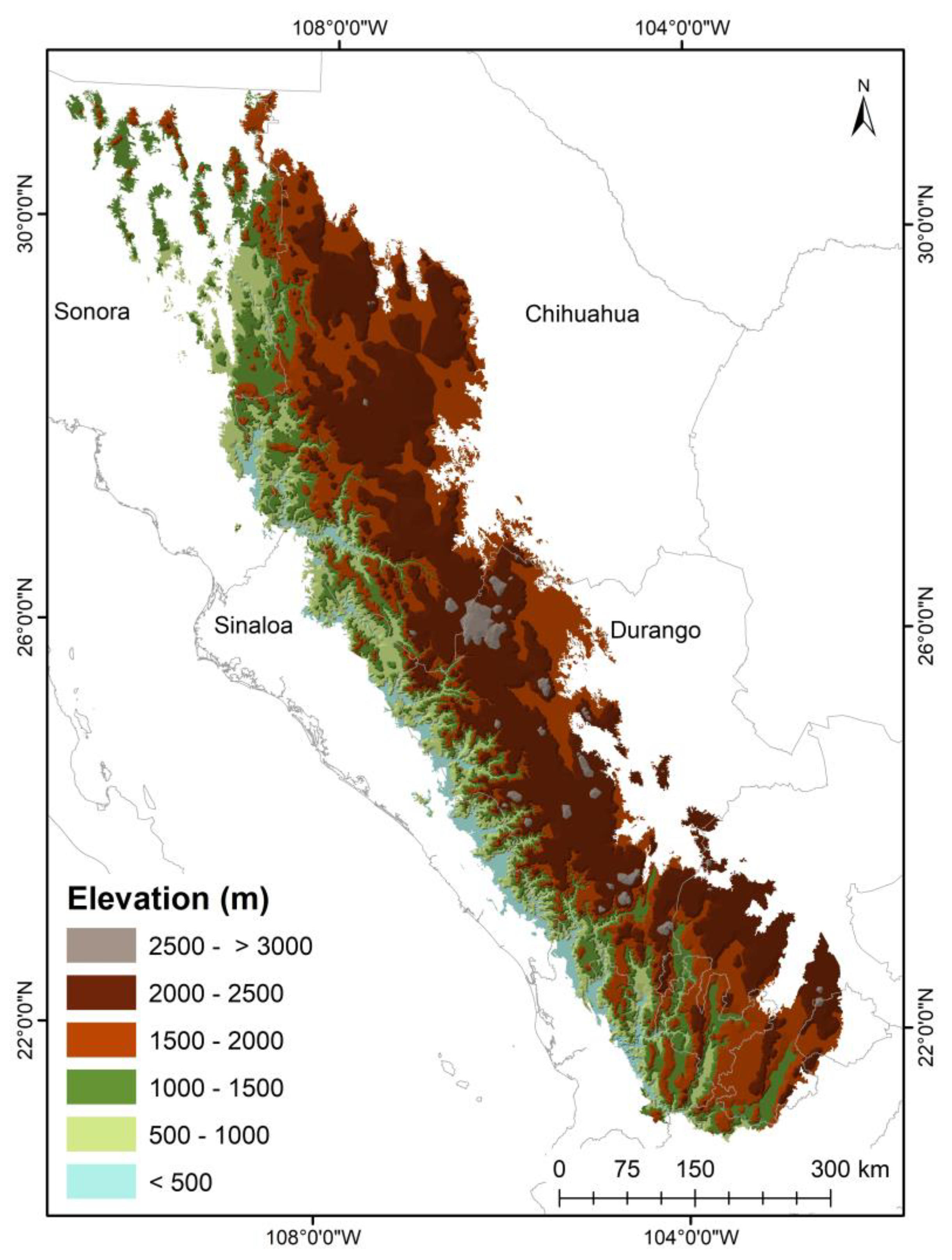
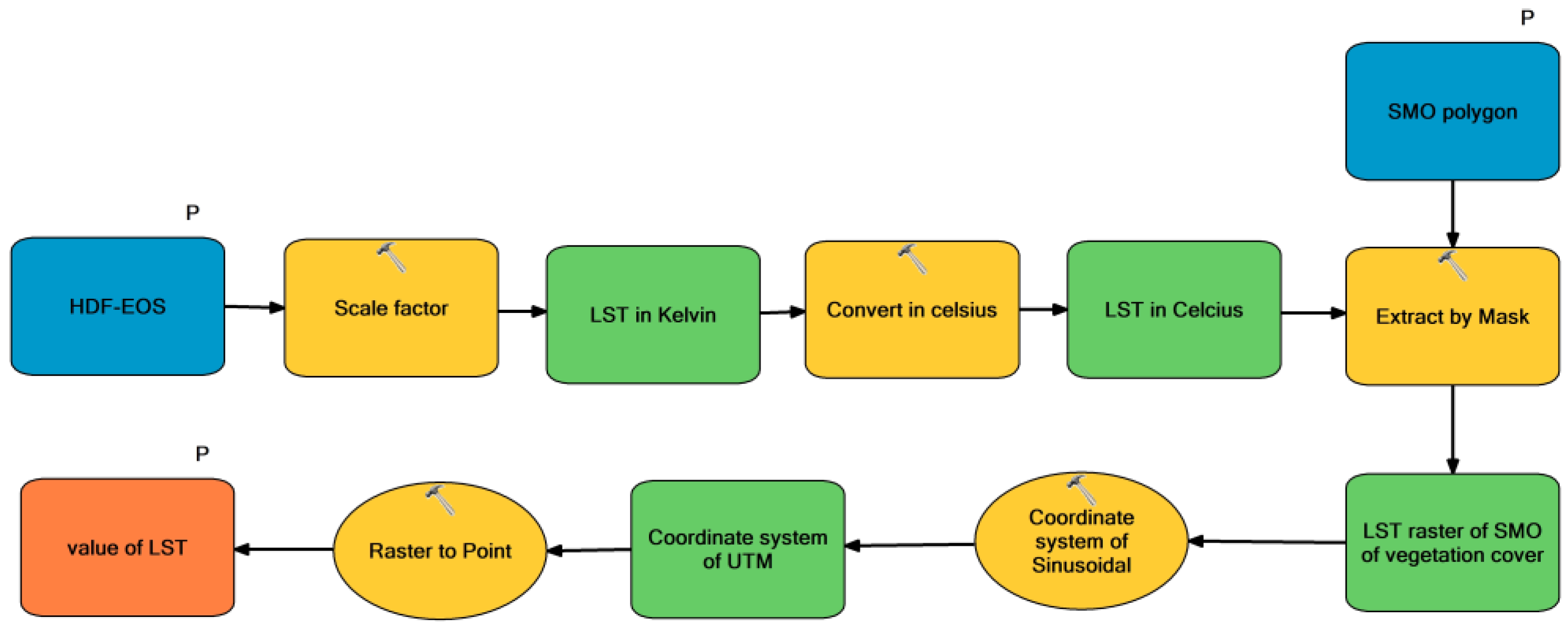
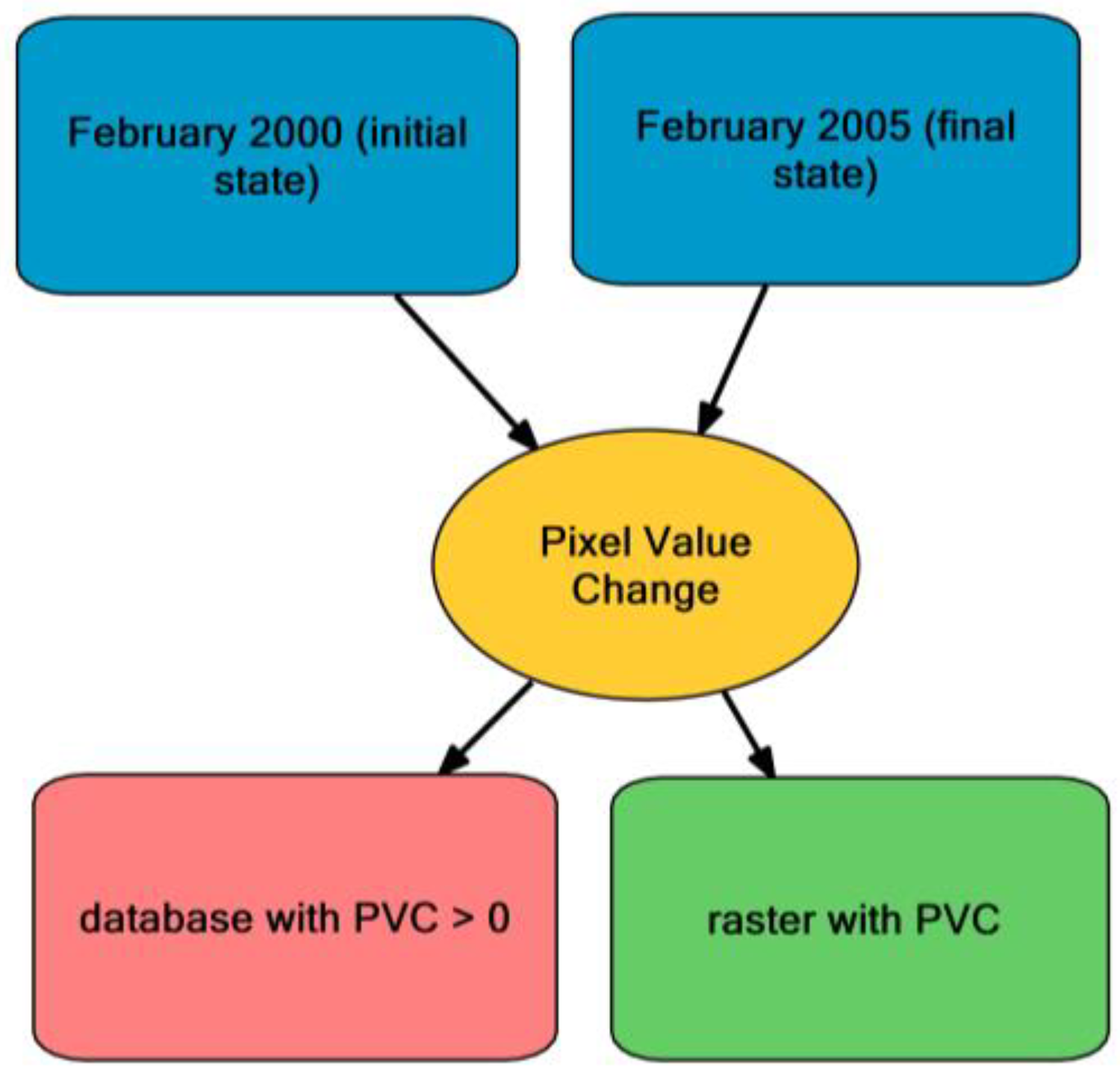
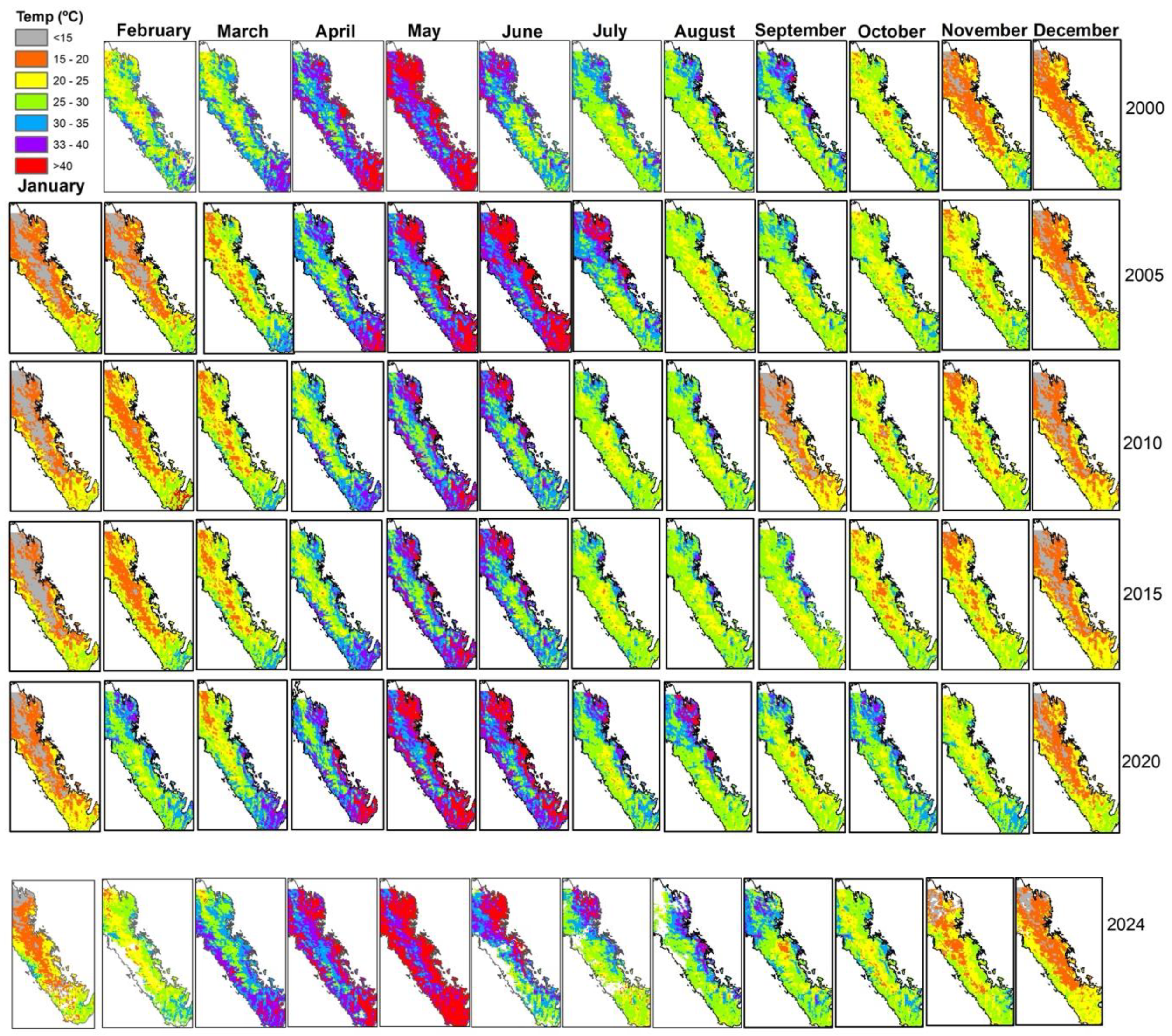

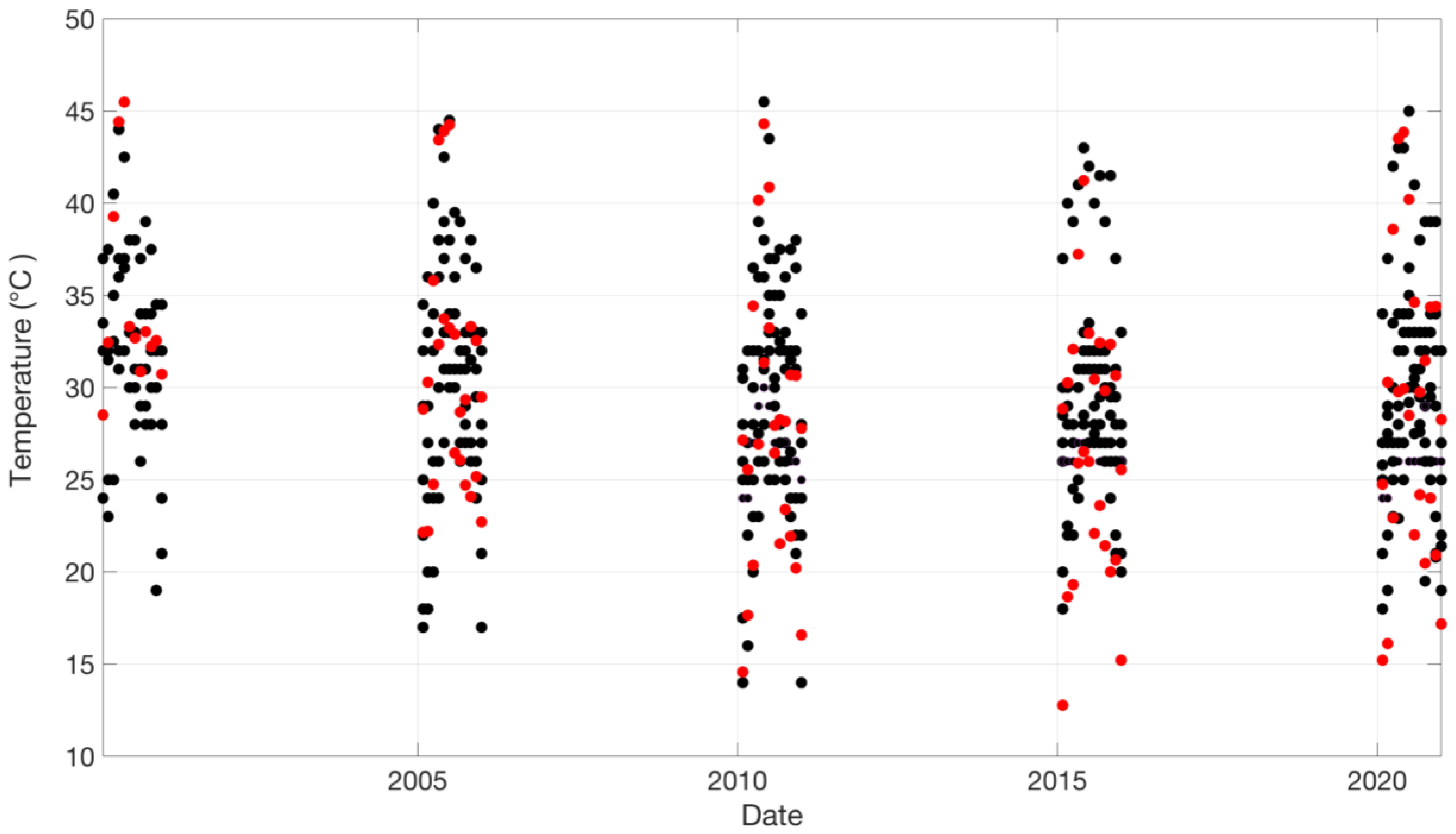
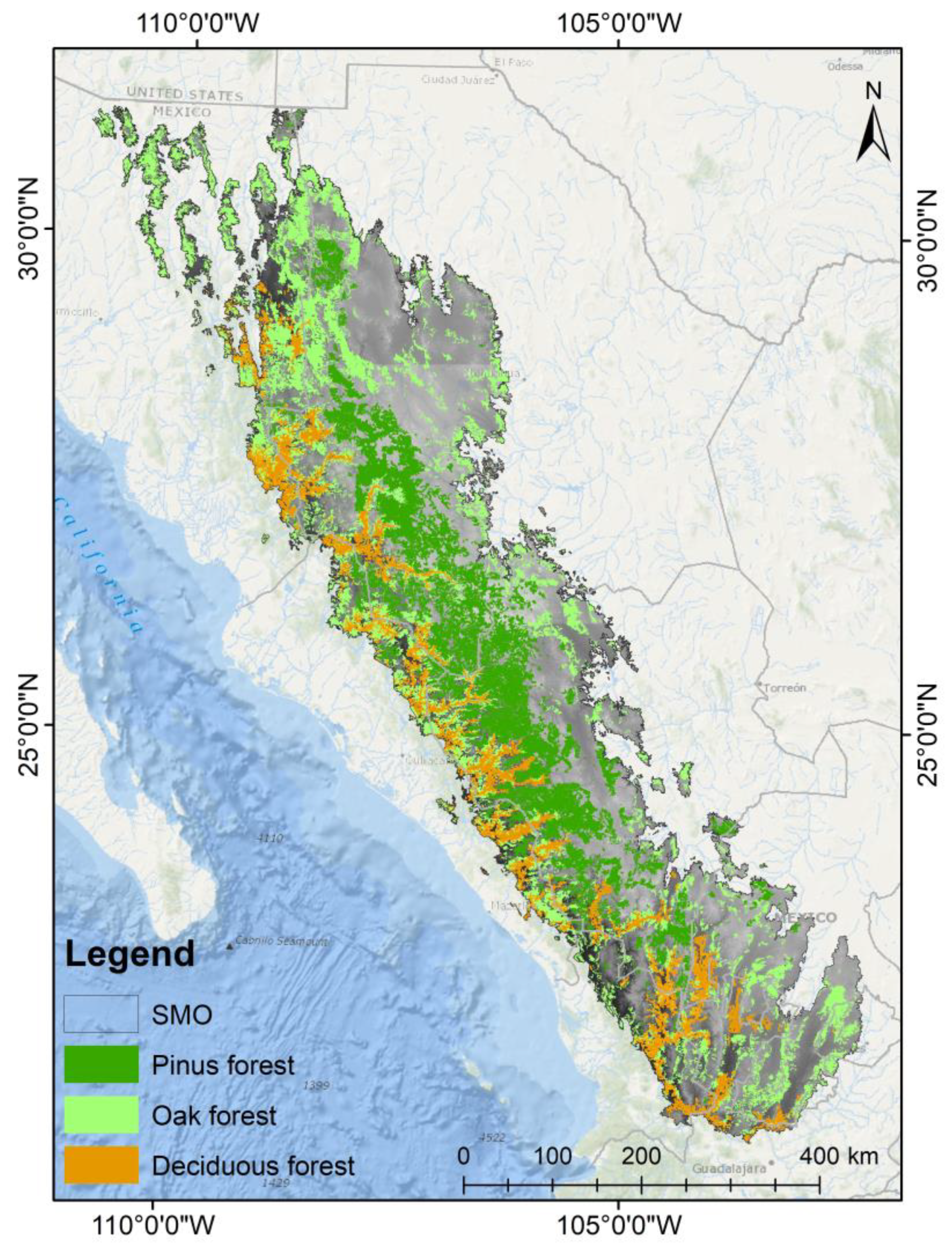
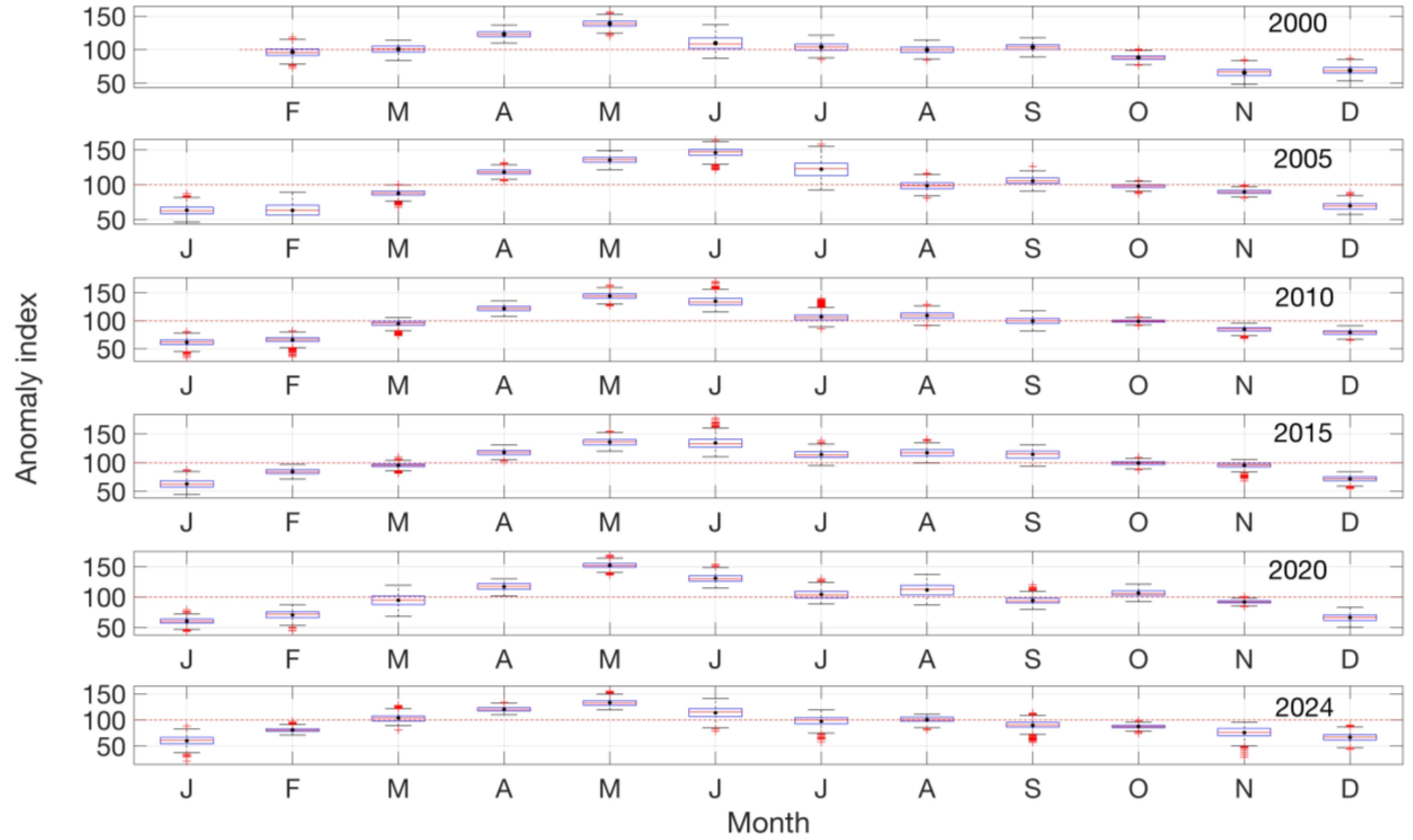
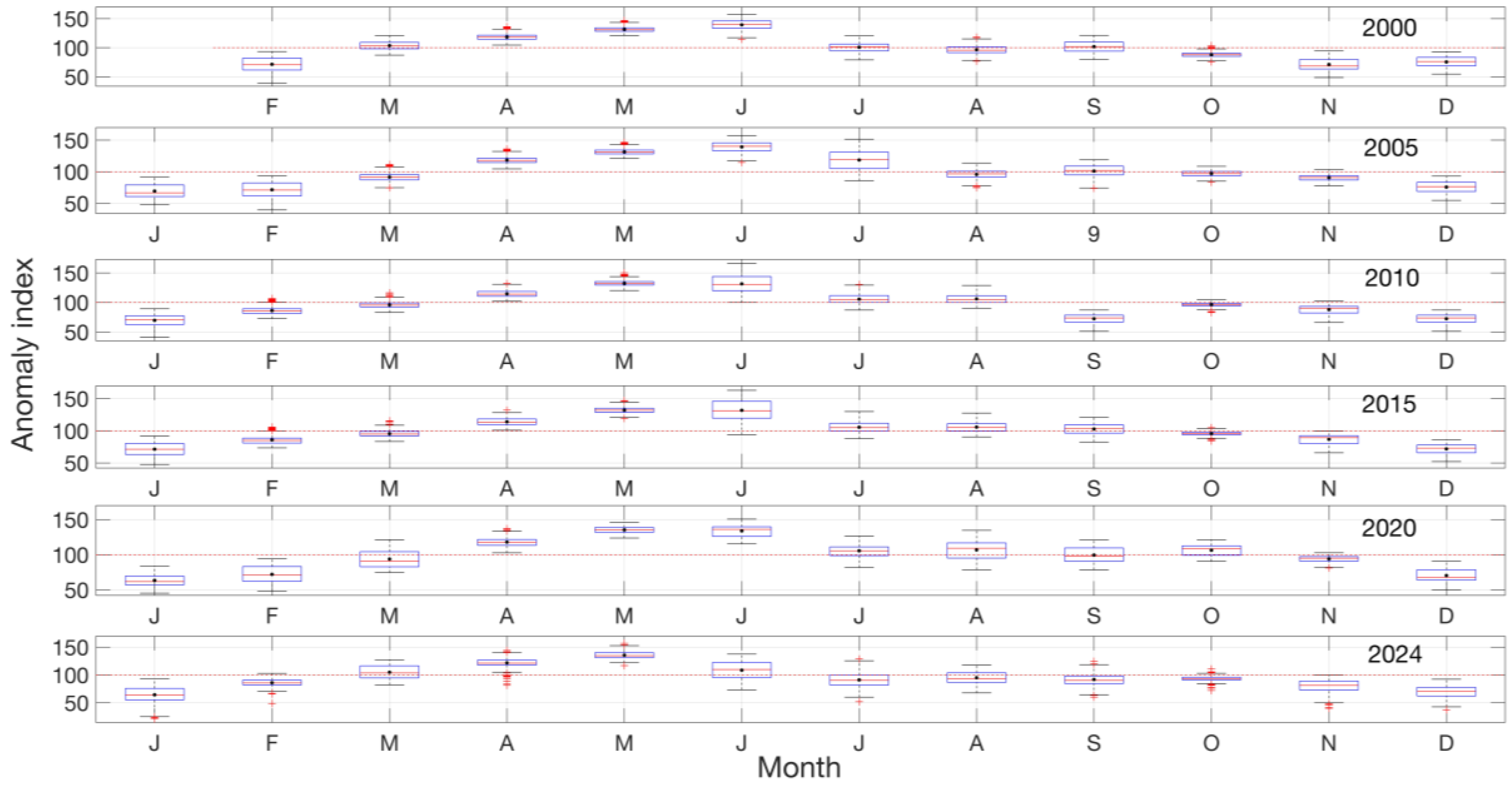

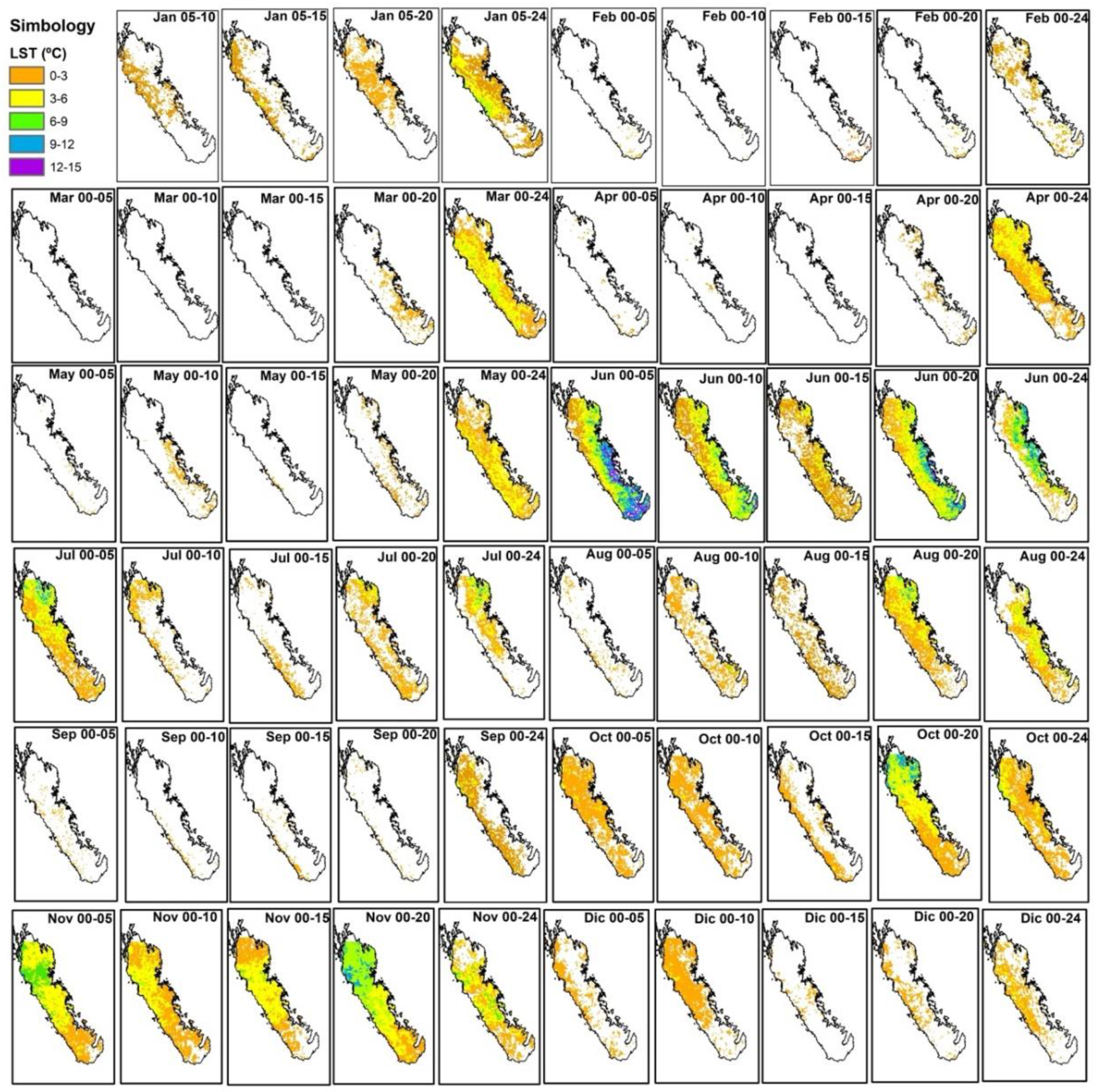
| Station Number | Year | Value of R2 | (RMSE) | Value of p |
|---|---|---|---|---|
| 10,160 Lat 24.44° Lon −105.78° | 2005 | 0.38 | 3.88 | 0.018 |
| 2010 | −0.03 | 5.81 | 0.438 | |
| 2015 | 0.7 | 2.31 | <0.001 | |
| 2020 | 0.13 | 4.67 | 0.129 | |
| 2005 | 0.38 | 3.88 | 0.018 | |
| 18,013 Lat 21.68° Lon −104.31° | 2000 | 0.28 | 7.85 | 0.04 |
| 2005 | 0.84 | 2.46 | <0.001 | |
| 2010 | 0.4 | 4.05 | 0.015 | |
| 2015 | −0.07 | 3.71 | 0.640 | |
| 2020 | −0.04 | 5.08 | 0.474 | |
| 25,093 Lat 25.80° Lon −107.56° | 2005 | 0.82 | 2.09 | <0.001 |
| 2010 | 0.12 | 4.38 | 0.140 | |
| 2015 | 0.43 | 2.89 | 0.011 | |
| 2020 | 0.73 | 2.34 | <0.001 | |
| 2005 | 0.82 | 2.09 | <0.001 | |
| 8219 Lat 29.25° Lon −108.09° | 2000 | 0.74 | 4.13 | <0.001 |
| 2005 | 0.89 | 3.22 | <0.001 | |
| 2010 | 0.87 | 5.15 | <0.001 | |
| 2015 | 0.95 | 0.87 | <0.001 | |
| 2020 | 0.80 | 4.73 | <0.001 | |
| 8215 Lat 28.71° Lon −107.24° | 2000 | 0.4 | 9.6 | 0.030 |
| 2005 | 0.89 | 3.13 | <0.001 | |
| 2010 | 0.72 | 5.79 | <0.001 | |
| 2015 | 0.83 | 2.07 | <0.001 | |
| 2020 | 0.86 | 3.4 | <0.001 | |
| 8352 Lat 28.18° Lon −108.21° | 2010 | 0.78 | 8.22 | <0.001 |
| 2015 | 0.18 | 23.45 | 0.156 | |
| 2020 | 0.28 | 31.15 | 0.07 | |
| 14,023 Lat 21.82° Lon −103.78° | 2000 | 0.81 | 5.95 | <0.001 |
| 2005 | 0.79 | 8.9 | <0.001 | |
| 2010 | 0.76 | 10.17 | <0.001 | |
| 2015 | 0.62 | 6.664 | 0.002 | |
| 2020 | 0.8 | 8.01 | <0.001 | |
| 14,053 Lat 22.60° Lon −103.94° | 2000 | 0.64 | 11.32 | 0.003 |
| 2005 | 0.78 | 8.85 | <0.001 | |
| 2010 | 0.57 | 18.24 | 0.004 | |
| 2015 | 0.57 | 7.57 | 0.004 | |
| 2020 | 0.8299 | 6.82 | <0.001 |
| Change (°C) | |||||
|---|---|---|---|---|---|
| Month | 2000–2005 | 2000–2010 | 2000–2015 | 2000–2020 | 2000–2024 |
| January | µ = 0.78 | µ = 1.38 | µ = 0.78 | µ = 2.73 | |
| No data | σ = 0.63 | σ = 1.11 | σ = 0.60 | σ = 1.90 | |
| n = 1036 | n = 1170 | n = 1554 | n = 2743 | ||
| max = 3.87 | max = 5.41 | max = 3.86 | max = 9.8 | ||
| February | µ = 1.63 | µ = 1.24 | µ = 1.87 | µ = 1.70 | µ = 1.50 |
| σ = 1.37 | σ = 1.35 | σ = 1.70 | σ = 1.73 | σ = 1.32 | |
| n = 69 | n = 9 | n = 114 | n = 88 | n = 1110 | |
| max = 5.55 | max = 3.77 | max = 7 | max = 7.04 | max = 9.35 | |
| March | µ = 1.71 | µ = 0 | µ = 0 | µ = 1.03 | µ = 3.35 |
| σ = 1.32 | σ = 0 | σ = 0 | σ = 0.85 | σ = 1.76 | |
| n = 4 | n = 1 | n = 0 | n = 649 | n = 3482 | |
| max = 2.63 | max = 0.02 | max = 0 | max = 4.77 | max = 7.77 | |
| April | µ = 0.16 | µ = 0.73 | µ = 0 | µ = 0.59 | µ = 2.75 |
| σ = 0.09 | σ = 0.53 | σ = 0 | σ = 0.38 | σ = 1.54 | |
| n = 41 | n = 39 | n = 0 | n = 397 | n = 3475 | |
| max = 0.33 | max = 2.4 | max = 0 | max = 1.37 | max = 8.55 | |
| May | µ = 0.16 | µ = 0.76 | µ = 0.77 | µ = 0.47 | µ = 2.81 |
| σ = 0.07 | σ = 0.57 | σ = 0.54 | σ = 0.32 | σ = 1.47 | |
| n = 60 | n = 487 | n = 48 | n = 623 | n = 3485 | |
| max = 0.27 | max = 3.03 | max = 2.57 | max = 1.19 | max = 6.39 | |
| June | µ = 6.98 | µ = 4.57 | µ = 2.21 | µ = 5.43 | µ = 5.12 |
| σ = 3.71 | σ = 2.75 | σ = 1.59 | σ = 2.99 | σ = 2.21 | |
| n = 4125 | n = 4101 | n = 3093 | n = 4144 | n = 2249 | |
| max = 13.95 | max = 14.33 | max = 9.50 | max = 15.27 | max = 13.72 | |
| July | µ = 3.67 | µ = 1.79 | µ = 0.88 | µ = 1.69 | µ = 3.14 |
| σ = 2.32 | σ = 1.37 | σ = 0.82 | σ = 1.55 | σ = 2.40 | |
| n = 3806 | n = 1197 | n = 576 | n = 2201 | n = 1729 | |
| max = 14.98 | max = 7.39 | max = 5.42 | max = 10.45 | max = 13.80 | |
| August | µ = 0.55 | µ = 1.05 | µ = 0.87 | µ = 3.07 | µ = 3.16 |
| σ = 0.53 | σ = 0.9 | σ = 0.74 | σ = 2.18 | σ = 2.07 | |
| n = 335 | n = 1664 | n = 1577 | n = 3289 | n = 2412 | |
| max = 3.46 | max = 6.89 | max = 5.51 | max = 12.85 | max = 9.48 | |
| September | µ = 0.55 | µ = 0.51 | µ = 0.71 | µ = 0.34 | µ = 1.8 |
| σ = 0.49 | σ = 0.49 | σ = 0.56 | σ = 1.14 | σ = 1.34 | |
| n = 397 | n = 134 | n = 293 | n = 345 | n = 2037 | |
| max = 3.10 | max = 2.19 | max = 3.58 | max = 0.55 | max = 8.95 | |
| October | µ = 1.57 | µ = 1.18 | µ = 1.11 | µ = 4.31 | µ = 2.17 |
| σ = 1.08 | σ = 0.84 | σ = 0.81 | σ = 2.36 | σ = 1.50 | |
| n = 3126 | n = 2805 | n = 1421 | n = 4093 | n = 3202 | |
| max = 6.72 | max = 5.85 | max = 5.72 | max = 14.70 | max = 9.08 | |
| November | µ = 4.37 | µ = 2.86 | µ = 3.29 | µ = 5.89 | µ = 3.19 |
| σ = 2.08 | σ = 1.42 | σ = 1.69 | σ = 2.47 | σ = 1.85 | |
| n = 4080 | n = 3919 | n = 3534 | n = 4224 | n = 2981 | |
| max = 10.23 | max = 8.91 | max = 8.58 | max = 12.92 | max = 9 | |
| December | µ = 1.00 | µ = 1.29 | µ = 2.26 | µ = 5.48 | µ = 1.79 |
| σ = 0.83 | σ = 0.92 | σ = 0.45 | σ = 0.71 | σ = 1.12 | |
| n = 1236 | n = 2612 | n = 303 | n = 937 | n = 1667 | |
| max = 4.32 | max = 5.06 | max = 2.26 | max = 5.48 | max = 6.57 | |
Disclaimer/Publisher’s Note: The statements, opinions and data contained in all publications are solely those of the individual author(s) and contributor(s) and not of MDPI and/or the editor(s). MDPI and/or the editor(s) disclaim responsibility for any injury to people or property resulting from any ideas, methods, instructions or products referred to in the content. |
© 2025 by the authors. Licensee MDPI, Basel, Switzerland. This article is an open access article distributed under the terms and conditions of the Creative Commons Attribution (CC BY) license (https://creativecommons.org/licenses/by/4.0/).
Share and Cite
Sandoval, S.; Escobar-Flores, J.G. Spatial Mapping of Thermal Anomalies and Change Detection in the Sierra Madre Occidental, Mexico, from 2000 to 2024. Land 2025, 14, 1635. https://doi.org/10.3390/land14081635
Sandoval S, Escobar-Flores JG. Spatial Mapping of Thermal Anomalies and Change Detection in the Sierra Madre Occidental, Mexico, from 2000 to 2024. Land. 2025; 14(8):1635. https://doi.org/10.3390/land14081635
Chicago/Turabian StyleSandoval, Sarahi, and Jonathan Gabriel Escobar-Flores. 2025. "Spatial Mapping of Thermal Anomalies and Change Detection in the Sierra Madre Occidental, Mexico, from 2000 to 2024" Land 14, no. 8: 1635. https://doi.org/10.3390/land14081635
APA StyleSandoval, S., & Escobar-Flores, J. G. (2025). Spatial Mapping of Thermal Anomalies and Change Detection in the Sierra Madre Occidental, Mexico, from 2000 to 2024. Land, 14(8), 1635. https://doi.org/10.3390/land14081635






